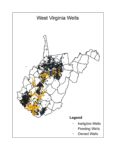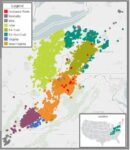Update September 2011: now ION is coming to Preston County (click for info)
Update August 2011: The experience of one landowner in Upshur County who signed a permit
The following was updated June 15 and 30, 2010 with important information about:
- Whether you can refuse to allow them to come on to your land to do 3D testing!
- Whether they can use the information they find about your minerals from doing testing on neighboring land.
- Links to the impact on the community as a whole from Marcellus Shale production.
- What if there is more than one owner of the minerals.
What we understand is happening: (Correct us if we have mistakes or if you hear more):
Dawson Geophysical has been contracted/authorized by at least Chesapeake Energy, and perhaps other gas producers in the area, to conduct both 2D (two dimensional) testing in a straight line, and 3D (three dimensional) testing over 80 square miles of southern Upshur and a bit of Randolph and Lewis counties.
For 3D testing, we understand that their goal is to drill rows of 3 inch diameter holes 20 feet deep (though some rumors say 50 feet deep) approximately every 190 feet going east – west. The rows will be parallel 1500 – 1700 feet apart north and south. At the bottom of each hole will be 2.2 pounds of ammonium nitrate explosive. If you have over 4 acres of surface it is likely they will at least want one charge on you. There will also be geophones placed over the area and wired together in order to record the sonar-like returns when the explosives are set off. There will be wires and cables hooking things together over the entire grid area. The charges may be set off by wires or radio waves. A survey crew will come through first to stake locations for the holes and geophones. (If one of those stakes is at a location near a water well, an underground pipeline, or a foundation etc. call and complain, and keep a diary of what happens.) To drill the holes, helicopters will lift portable drilling units to crews working on the ground. (Click here to read an article from the Wetzel Chronicle about similar testing conducted in Wetzel County in 2009.)
For 2D testing they are going in one straight line of explosive charges and geophones for a much longer distance.
Citizen concerns:
The most significant thing about this is that it means the Chesapeake and others believe that the Marcellus Shale is thick enough and rich enough in the area to seriously investigate a Marcellus Shale (or other shale) drilling program here.
A major Marcellus Shale drilling program will have a huge impact on the community even for people who have no drilling on them. Roads are going to be impacted by hundreds and hundreds of huge tractor trailer truck loads of water sand and powerful drilling equipment. It will punish the roads and crowd them too, making it difficult and even more dangerous for other users, like school buses. For more on that go to the web site of the Wetzel County citizen group that has already had to deal with these problems see web sites in Pennsylvania such as http://extension.psu.edu/naturalgas that are further ahead than West Virginia in dealing with all of this. Sadly, there will only be a scattering of jobs for local West Virginians. Most of the drilling companies are bringing in workers from Oklahoma and Texas making business for motels, but not much hiring.
If you own only the surface, this could mean heartbreaking use of your surface to get the gas out. Fortunately they will probably be using horizontal drilling using centralized well pads for y or more wells, reducing the number of well pads necessary, but there will still be lots of impact, and extra impact on the surface where the 6 plus wells are drilled. (Look elsewhere on the WVSORO web site for more information on horizontal drilling.) If you own the surface and the minerals and a lease has already been signed, it could mean that there will be use of your surface, but you may get significant royalty income. If you own surface and minerals and a lease has not been signed, you can decide whether you want the royalty and the associated surface use.
If they are right that this is a good Marcellus are, there will be lots of wells. If you own both the surface and minerals and no lease has been signed for your tract, you should go to the leasing page of this web site. If you are a surface owner , or if there has already been a lease signed that does not give you the protections that you would like, you should start getting ready now. Here’s what you should do:
- We suggest that you get a copy of the West Virginia Surface Owners Guide to Oil and Gas, and that you go to our home page and start at the top left under “What should I do?” in order to view the web pages for updates to the Guide. Also on the home page on the top left under “Resources” you will find a number or other useful web pages including a slide show explaining how a gas well is drilled and what can go wrong, for horizontal drilling etc.
- If you do not own the minerals under your land, try to find out who does. The Surface Owners’ Guide explains how to do this in simple cases, but you might need professional help in more complicated case. Often they are in heirship and you can find an owner who is sympathetic or who wants some cash now for their small share of the mineral ownership. If you own a % of the minerals, and no one has leased yet (or if the current lease expires), then the driller cannot drill unless they get each and every mineral owner (now including you if you can buy a small share) to sign the lease.
- If you have a future home site or other reasonable use of the land you want to preserve, drill a water well! The law prohibits them from drilling a gas well within 200 feet of a water well. The State permitting process will enforce this. (If you drill wells every 400 feet apart all across your land with no good reason other than to block the driller, then they might be able to take you to court and you might lose, but no one has tried it yet.)
- There are other tips and ideas in the Guide and on our the website.
More immediate concerns:
- (Here is “Q&A” section on the subject of seismic activity from the West Virginia Surface Owner’s Guide to Oil and Gas. It was written in 2004 and is a little dated since this was before the Marcellus Shale and 2D and 3D Seismic exploration.)
- Impact on farm animals and wildlife nesting etc. from helicopter and other disturbances and the blasts themselves. To our knowledge, the impact on wildlife is unknown. The Wetzel County Action Group reported that a horse was injured as a result of seismic testing in the county. The incident occurred in May 2009. If you know of other incidents or have information about the impacts on wildlife, please let us know. (Unknown. Help us out!)
- Impacts on the water tables from drilling the holes. (These holes are very much shallower than gas well holes that can drain a water table (at least temporarily) because gas wells are drilled thousands of feet into the ground, while holes for seismic testing are usually only 100 feet deep at the most, and may be only 20 feet deep this time. Also since they are shallow they do not penetrate deeper salt or iron water formations and gas and oil formations that could percolate upward to cause pollution of groundwater. )
- How are they going to plug the wells holes when they are done? (This may be important so the holes are not conduits for surface pollution (think cow pasture) seeping down into the water table, etc. We have heard they are going to use Bettonite Gel which is the best thing, rather than just filling it back in which what they dug out. )
- Knowing when the surveyors will come, knowing when the helicopters will fly over and the drilling will occur, and knowing when the blast(s) will happen. (We’d like to know when to be prepared and to watch for problems and to control animals.)
- Impact of the explosions on water wells and foundations. (They avoid setting charges off near water wells. Let them know where yours are even if you do not consent. Foundation impacts are probably rare, but we understand they have been known to happen, so it would not hurt to take a some pictures of yours before the blast.)
- Surface disturbance. (They are using helicopters to move the drilling rigs so there will not be as much road building as has accompanied this activity in other areas. But there will be people on your land and we do not know for sure what disturbance will still happen.)
- Unexploded charges. (In a similar project out west several years ago we understand that it was estimated that 10% of the charges did not detonate. If they would not go off intentionally can they still go off accidentally, and what would be the result? What if years from now you hit one with a bulldozer building a foundation? Ammonium nitrate is a fertilizer, but is that all that will be left?)
Your legal rights.
This is a massive project. Although some say they are finding out who owns what before coming to surface owners, we have also heard that they are asking everyone on the surface for permission to do the work without necessarily investigating to see whether the surface owners own the minerals or have leased them, or if there is a lease from the surface owner or a mineral owner, who owns the lease. It may be cheaper for them to pay $3 an acre to everyone than it is to check all the titles of all the tracts of surface land in order to see if they already have permission (see below). If they do run into an unwilling surface owner and they feel that they have the right to use the surface based on permission from the mineral owner or a lease, and if they feel they need permission for that land, they have sued.
Situation #1. If you own the surface and minerals and no lease has been signed, they cannot come on to your land without your permission. You can just say “No,” and there is nothing they can do. They do not have eminent domain to do this. (They can walk across your land etc. unless it is “enclosed” or “cultivated” or unless you put up “No Trespassing” signs or unless, if you see them, you ask them to leave.) (Note that the explosions they shoot off near your land, using 3D seismic techniques, will tell them something about the formations under your land. They may not even be able to retain or give out the information they learn about what what is under your land. If you are worried that, for examp[le, they will find out that your minerals are not all that great, reducing their value to lease, you should contact a lawyer.)
Situation #2. If you own surface and minerals and a lease has been signed, the company that currently has that lease (or its agent/contractor) can come onto your land to do geophysical testing that was permitted by the lease or that only causes surface disturbance that was in the contemplation of the parties at the time of the lease (more on that last phrase later). However, WVSORO believes that they cannot do 3D testing on your land to find out about the minerals under other people’s land without your express permission. More on that under Situation #3.
Just because someone has the right to do this does not mean that just anybody can come on to your land. It has to be the person with the mineral owner’s lease, not just someone who believes they are. Unless the person doing the testing can show you the lease, can show you that the person that signed the lease once owned your land, and can show you the chain of the assignments of that lease that means they now own the lease (or they work for whomever does), then they cannot come onto your land without your permission. (But note that if that lease is owned by Exxon, and Chesapeake wants to do the testing, then Chesapeake can do the testing if they show you a piece of paper in which Exxon says they gave Chesapeake permission to do the testing.) If they do not do that and they come onto your land, and you ask them to leave and they do not leave, then they are trespassing. If someone is trespassing and you call a law enforcement the officer, the officer should ask them to leave and tell them it is a civil matter to be settled in the courts.
Situation #3. If you own the surface but not the minerals, and if the mineral owner signed a lease, then the company that currently has that lease (or its agent/contractor) can come on onto your land to do the seismic testing:
1) If what they are doing only causes surface disturbance that is “fairly necessary” and that was in the contemplation of the parties (more on that phrase later) at the time that the ownership of the surface was separated from ownership of the minerals,
2) If it was set out in the lease from the mineral owner (although if it was not set out in the lease they can go back to the mineral owner(s) and get permission – if they can find them all). Again this does not mean that just anybody can come on to your land – its got to be the one with the lease/permission (See Situation #2 above.), and
3) IF (and this is the most important “if”) they are testing the minerals under your surface! WVSORO has recently come upon legal authority for the position that they cannot use your surface to test the minerals under neighboring lands (unless they were part of the same tract at the time that the ownership of the minerals and surface that became your tract were separated). In essence, WVSORO believes that this means that they cannot do 3D testing on your surface without your permission. The law is not absolutely clear. There is no statute on this, and there has not been a test case in West Virginia courts, but according to treatises on they law, this is what the law is.
Note however that if the minerals are owned by more than one owner (whether they own just the minerals or also own the surface with the minerals), then Chesapeake/Dawson can come on to your land to do the seismic exploration even if they only have the permission of one of the owners of the minerals. They cannot drill and produce unless they have the signature of all of the mineral owners, but just one owner is allowed to have someone investigate what that owner has a share of. So Chesapeake/Dawson only needs the permission of one of the mineral owners to proceed with the seismic testing.
Contemplation of the parties. Does it apply here to keep them from doing 3D seismic?
What does, “contemplation of the parties” mean? That term was used several times above.
When ownership of the coal was first separated from ownership of the surface, only deep mines were used to produce the coal. Later when strip mining started, mining companies tried to strip mine using based on the old deeds. The Court ruled that since strip mining was not in the contemplation of the parties at the time of the severance, the surface land could not be strip mined.
That theory has been applied in other circumstances. Could that theory could apply to prevent 2D or 3D seismic exploration for oil and gas? The mineral owner may be is allowed to do what is “fairly necessary” to the surface, but if the severance of the oil and gas from the surface took place before this kind of seismic was known, or if the lease was signed before it was known, then it could be argued that it is not permissible because the surface disturbance is greater and not in the contemplation of the parties. However, the disturbance caused by this seismic is nothing like the difference between deep coal mining and strip mining. This theory could possibly work to deny seismic activity, but it is much more likely to work in a situation where, for example, they try to put a drilling pad for 6 or 8 Marcellus Shale wells on surface that was severed in 1899. There is a little more about this in the West Virginia Surface Owner’s Guide to Oil and Gas.So keep this theory in mind if they really come to drill on you, and you can try to use it to stop geophysical, but it is probably a tough case.
What should I say and what should I not say?
Do NOT say anything that MIGHT be taken as a threat to “breach of the peace” – you know what we mean. If you do that, and if they take you to court, you will not be well received by the Judge.
If you are in situation #1, you can just say, “no,”, or you can sign the permit/consent form with whatever conditions you can negotiate. If you say, “no,” and they come on anyway, take pictures and call the law.
In situations #2 and #3, for 2D testing, you can simply say, “Prove to me that you are the one with the right to come on to my land, and I will not interfere.” You do not have to sign the permit/consent form if you do not want to. Do NOT threaten to stop them if they have reasonable proof that they are the ones with the right to come on to your land, at least for 2D. That will give them an excuse, if you end up in court, to at least sue you for damages. They may or may not pursue those damages, but you will have handed them a huge bargaining chip/leverage.
In situations #2 and #3, for 3D testing, WVSORO believes with good legal authority that you can just say,”No” — that they cannot use your surface to test the minerals under neighboring tracts (that were not part of your surface tract at the time the ownership of the minerals). If you end up getting sued over this issue please contact us and we may be able to help you.
In all situations, follow the advice we give all surface owners in any dealings with oil and gas companies. Keep a diary of all conversations and other communications with the oil and gas companies, their representatives or contractors; get names and phone numbers. Do not get into a heated argument with the person who approaches you. If you are not getting anywhere, or if the other side is misbehaving, simply ask to speak to their supervisor; and if that does not work, get on the Internet, and call the company president and work your way down to their supervisor. Also take lots pictures from different angles, from close up and way back, and from this side and from that side — before, during and after – it is very hard to argue with a picture.
What if there is damage to my property?
Note that the permit/consent form says that they agree to hold you harmless if someone else sues you over the work they are about to do. That is different from agreeing to reimburse you for damages they do to YOU!
If you are in situation #1, #2, or #3, and if you signed a permit and agreed to take $3 an acre, and if there is disturbance to the surface etc. that occurs from the normal, expected course of their work, then $3 an acre is probably all you are going to get. They are probably going to take the position that this is what they paid you $3 an acre for.
If you are in situation #1 and you did not sign a permit, they should not be there at all. If any damages occurs to your land from what they do on a neighbors land, see a lawyer.
If you are in situation #2 or #3, and if you did not sign a permit, and if there is disturbance to the surface etc. that occurs from the normal, expected course of their work, then they are probably going to take the position that you are not entitled to any damages. They will say that they had the right to do the work as part of their right to explore for and produce the gas, and they only did what was in the lease (situation #2) or what was “fairly necessary” (situation #3) and they do not have to pay you anything. They might at that point still agree to pay you $3 an acre. However, if they do 3D testing, then you may be entitled to compensation for damages to your surface, and maybe double damages, and maybe more, see a lawyer. And as stated above you might be able to argue that they are doing something that was not in the lease (situation #2) or not “in the contemplation of the parties” at the time of the severance (situation #3), and so you should be entitled to damages. We are not ruling that out, but we doubt if a lawyer will take such a case on a contingent fee basis.
However, you probably will be entitled to damages if the blasting causes problems, or if they are negligent in the other things they do. Also, if you are in situation #2 and they do more than the lease provides, you may be entitled to damages. Finally, if you are in situation #3, and they do more than was fairly necessary you should be entitled to damages. So if there is surface or other damage because they were negligent, or did more than was “fairly necessary” or did not perform in a workman like manner, or as a result of the blasting, or if the did 3D testing, they would have to reimburse you, . If they will not, see a lawyer.
If I sign their permit/consent form, is there anything special I should do?
You should insist under the “conditions” section of the permit that they give you notice before they come onto your land to survey and to drill the holes, and when they are going to set off the charges – and give them a way to contact you. Let them know if there are water wells, pipelines, foundations on the land and tell them as best you can where they are located. You can try to say that they have to reimburse you for damages done, but they make take the position that what the $3 is for and not accept that condition.
If you have questions, WVSORO might be able to answer them. If you have serious damages, you may want to go straight to a lawyer.




